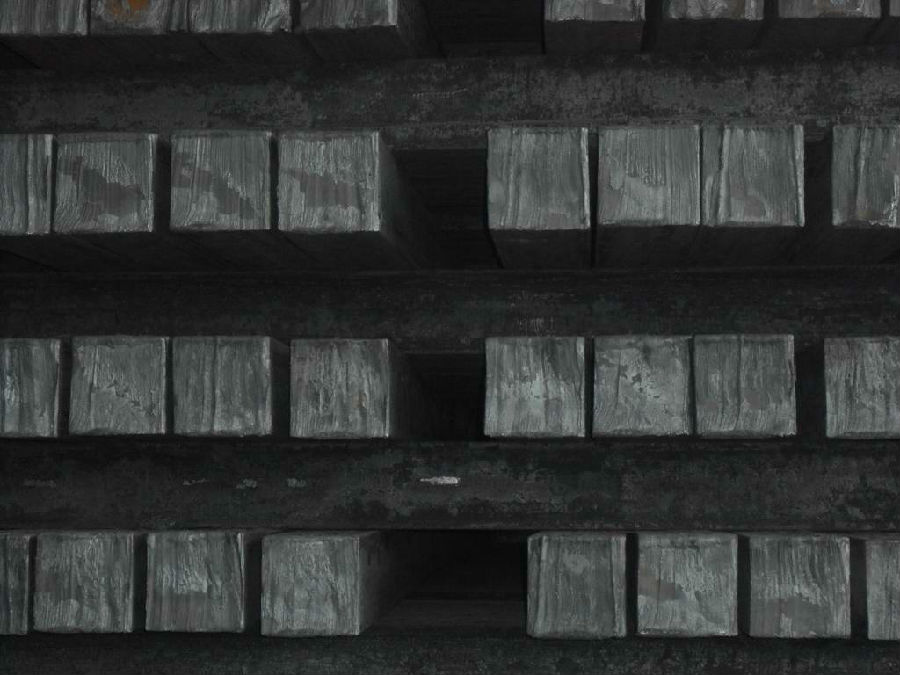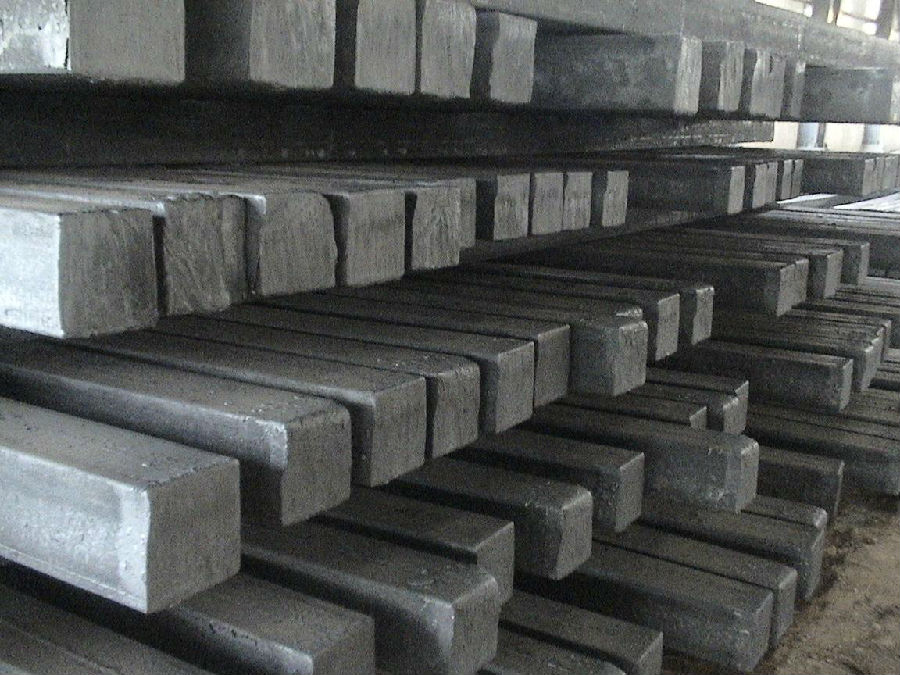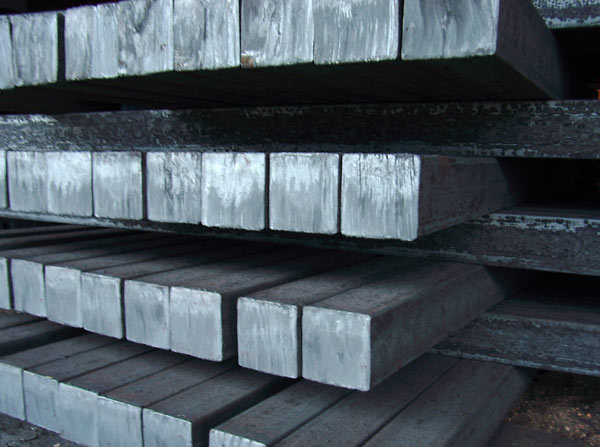Carbon Steel Billets Square Billets High Quality
- Loading Port:
- Tianjin
- Payment Terms:
- TT OR LC
- Min Order Qty:
- 24 m.t.
- Supply Capability:
- 24000 m.t./month
OKorder Service Pledge
OKorder Financial Service
You Might Also Like
Specifications
square steel billets 3sp & 5sp grade
1.3SP, 5SP
2.terms of payment: L/C at sight
3.size: 50~150mm
4.length: 5.8~12m
Specifications
| product name | square steel billets 3sp & 5sp grade |
| main types |
|
| size |
|
| application | 1.M.S. Billets are used for rolling of TMT Re-Bars of Fe415 and Fe500 Grade and various other structural steel products. 2.CRS Billets are used fro rolling of CRS TMT Re-Bars. 3.Special Alloy Billets are used for rolling of any special grade TMT Re-Bars like Earthquake resistant TMT Re-Bars and for special grade structural steel products. |
| notes | We produce world class quality steel billets which meets the specific requirements of the clients |



- Q:What is the typical yield strength of a steel billet?
- The typical yield strength of a steel billet can vary depending on the specific grade and composition of the steel. However, in general, steel billets have a yield strength ranging from 300 to 500 megapascals (MPa). It is important to note that this is just a general range, and the actual yield strength can be higher or lower depending on factors such as the steel's alloying elements, heat treatment, and processing techniques.
- Q:What are the environmental impacts of producing steel billets?
- The production of steel billets has several environmental impacts. One significant impact is the emission of greenhouse gases, particularly carbon dioxide, during the steelmaking process. This contributes to climate change and global warming. Additionally, the extraction of raw materials for steel production can lead to deforestation, habitat destruction, and soil erosion. Steel production also consumes large amounts of energy and water, which can strain natural resources and contribute to pollution. Proper management of these impacts, such as adopting more sustainable production methods and recycling, can help mitigate the environmental effects of steel billet production.
- Q:How are steel billets used in the production of structural sections?
- Steel billets are an essential raw material in the production of structural sections. These sections, such as beams, columns, and girders, are crucial components in the construction industry and are used to create sturdy and durable buildings, bridges, and other infrastructure. To begin the production process, steel billets are heated to extremely high temperatures in a furnace. This process, known as "hot rolling," makes the steel more malleable and easier to shape. Once the billets have reached the required temperature, they are passed through a series of rollers to gradually reduce their thickness and shape them into the desired structural section. The hot rolling process ensures that the steel maintains its strength and structural integrity while being shaped. It also helps to align the grain structure of the steel, resulting in improved strength and ductility. Moreover, the hot rolling process eliminates any internal stresses within the steel, making it less prone to cracking or failure. After the hot rolling process, the structural sections are cooled down and then cut to the desired length. They may also undergo additional treatments, such as straightening or surface finishing, to meet specific requirements or improve their aesthetics. Overall, steel billets play a crucial role in the production of structural sections. By providing the raw material that is shaped and processed, steel billets ensure that the resulting sections possess the necessary strength, durability, and stability required for construction projects.
- Q:What are the different types of cutting machines used for steel billets?
- There are several different types of cutting machines used for steel billets, including bandsaws, circular saws, plasma cutters, and waterjet cutters. Each type of machine has its own advantages and disadvantages depending on factors such as the required precision, cutting speed, and material thickness.
- Q:How are the surface defects of steel billets repaired?
- The surface defects of steel billets are repaired through a process called grinding or machining. This involves removing the defective areas by using specialized tools and techniques to smoothen out the surface and make it suitable for further processing or use in various industries.
- Q:What does "billet" mean?
- Steelmaking and continuous casting of steel products are mainly used for steel rolling, such as round bar, wire rod, sheet metal and so on
- Q:Can steel billets be forged?
- Indeed, steel billets have the capability to undergo forging, which is a widely employed technique for manipulating metals into desired configurations through the application of compressive forces. Steel billets, rectangular bars that serve as intermediate products, can be subjected to forging in order to convert them into a range of shapes, including bars, plates, and intricate geometries. When undertaking the forging process, the steel billets are first heated to a precise temperature to render them malleable, after which they are subjected to mechanical forces using hammers, presses, or other forging machinery. This process facilitates the shaping and compression of the billets, thereby enhancing their mechanical properties and bestowing them with specific characteristics that align with desired specifications. In summary, the forging of steel billets plays a vital role in the production of diverse metal components and products.
- Q:How are steel billets inspected for surface cleanliness?
- Steel billets are inspected for surface cleanliness through a series of visual and nondestructive testing methods. One of the commonly used techniques is visual inspection, where trained inspectors visually examine the surface of the billets for any visible impurities, such as scale, rust, dirt, or any other contaminants. This method helps identify any surface irregularities that may affect the quality of the billets. Additionally, nondestructive testing methods like magnetic particle inspection (MPI) and ultrasonic testing (UT) are employed to further evaluate the surface cleanliness of steel billets. Magnetic particle inspection involves applying a magnetic field to the billet's surface and then applying iron particles to it. If any surface cracks or defects are present, the iron particles will be attracted to these areas, making them visible to the inspector. Ultrasonic testing, on the other hand, uses high-frequency sound waves to detect any internal or surface defects. A probe is placed on the billet's surface, and sound waves are transmitted into the material. These waves are then reflected back to the probe and analyzed to identify any defects, such as inclusions or voids, which may affect the surface cleanliness. Overall, a combination of visual inspection, magnetic particle inspection, and ultrasonic testing is used to ensure that steel billets meet the required surface cleanliness standards. These inspection methods help identify any impurities or defects that could potentially compromise the quality and performance of the final steel product.
- Q:What are the different methods of steel billet surface inspection?
- There are several methods of steel billet surface inspection, including visual inspection, magnetic particle inspection, ultrasonic testing, and eddy current testing. Visual inspection involves examining the surface for any visible defects or irregularities. Magnetic particle inspection uses magnetic fields and iron particles to detect surface cracks or discontinuities. Ultrasonic testing uses high-frequency sound waves to detect internal defects or anomalies in the billet's surface. Eddy current testing involves passing an electrical current through the billet and detecting changes in the current caused by surface defects. These methods help ensure the quality and integrity of steel billets before further processing or use.
- Q:How are steel billets used in the manufacturing of industrial compressors?
- Steel billets are crucial in the manufacturing of industrial compressors as they serve as the raw material for forging or machining the various components of the compressors such as cylinders, pistons, and crankshafts. These billets are heated and shaped through different manufacturing processes to create the desired compressor parts, ensuring strength, durability, and high performance in the final product.
1. Manufacturer Overview |
|
|---|---|
| Location | |
| Year Established | |
| Annual Output Value | |
| Main Markets | |
| Company Certifications | |
2. Manufacturer Certificates |
|
|---|---|
| a) Certification Name | |
| Range | |
| Reference | |
| Validity Period | |
3. Manufacturer Capability |
|
|---|---|
| a)Trade Capacity | |
| Nearest Port | |
| Export Percentage | |
| No.of Employees in Trade Department | |
| Language Spoken: | |
| b)Factory Information | |
| Factory Size: | |
| No. of Production Lines | |
| Contract Manufacturing | |
| Product Price Range | |
Send your message to us
Carbon Steel Billets Square Billets High Quality
- Loading Port:
- Tianjin
- Payment Terms:
- TT OR LC
- Min Order Qty:
- 24 m.t.
- Supply Capability:
- 24000 m.t./month
OKorder Service Pledge
OKorder Financial Service
Similar products
New products
Hot products
Related keywords





























